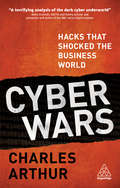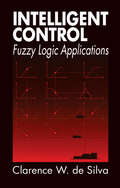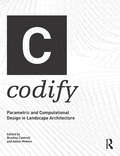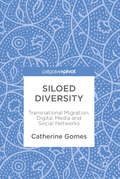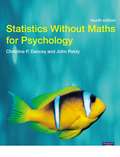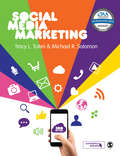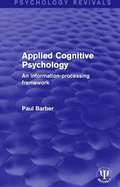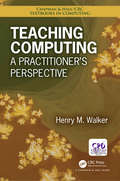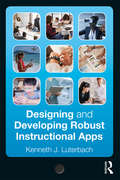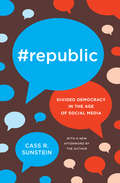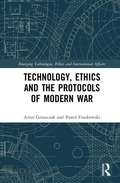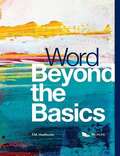- Table View
- List View
Cyber Wars: Hacks that Shocked the Business World
by Charles ArthurCyber Wars gives you the dramatic inside stories of some of the world's biggest cyber attacks. These are the game changing hacks that make organizations around the world tremble and leaders stop and consider just how safe they really are. Charles Arthur provides a gripping account of why each hack happened, what techniques were used, what the consequences were and how they could have been prevented. Cyber attacks are some of the most frightening threats currently facing business leaders and this book provides a deep insight into understanding how they work, how hackers think as well as giving invaluable advice on staying vigilant and avoiding the security mistakes and oversights that can lead to downfall. No organization is safe but by understanding the context within which we now live and what the hacks of the future might look like, you can minimize the threat. In Cyber Wars, you will learn how hackers in a TK Maxx parking lot managed to steal 94m credit card details costing the organization $1bn; how a 17 year old leaked the data of 157,000 TalkTalk customers causing a reputational disaster; how Mirai can infect companies' Internet of Things devices and let hackers control them; how a sophisticated malware attack on Sony caused corporate embarrassment and company-wide shut down; and how a phishing attack on Clinton Campaign Chairman John Podesta's email affected the outcome of the 2016 US election.
Cyber Wars: Hacks that Shocked the Business World
by Charles ArthurCyber Wars gives you the dramatic inside stories of some of the world's biggest cyber attacks. These are the game changing hacks that make organizations around the world tremble and leaders stop and consider just how safe they really are. Charles Arthur provides a gripping account of why each hack happened, what techniques were used, what the consequences were and how they could have been prevented. Cyber attacks are some of the most frightening threats currently facing business leaders and this book provides a deep insight into understanding how they work, how hackers think as well as giving invaluable advice on staying vigilant and avoiding the security mistakes and oversights that can lead to downfall. No organization is safe but by understanding the context within which we now live and what the hacks of the future might look like, you can minimize the threat. In Cyber Wars, you will learn how hackers in a TK Maxx parking lot managed to steal 94m credit card details costing the organization $1bn; how a 17 year old leaked the data of 157,000 TalkTalk customers causing a reputational disaster; how Mirai can infect companies' Internet of Things devices and let hackers control them; how a sophisticated malware attack on Sony caused corporate embarrassment and company-wide shut down; and how a phishing attack on Clinton Campaign Chairman John Podesta's email affected the outcome of the 2016 US election.
Intelligent Control: Fuzzy Logic Applications
by Clarence W. de SilvaThe emergence of fuzzy logic and its applications has dramatically changed the face of industrial control engineering. Over the last two decades, fuzzy logic has allowed control engineers to meet and overcome the challenges of developing effective controllers for increasingly complex systems with poorly defined dynamics. Today's engineers need a working knowledge of the principles and techniques of fuzzy logic-Intelligent Control provides it.The author first introduces the traditional control techniques and contrasts them with intelligent control. He then presents several methods of representing and processing knowledge and introduces fuzzy logic as one such method. He highlights the advantages of fuzzy logic over other techniques, indicates its limitations, and describes in detail a hierarchical control structure appropriate for use in intelligent control systems. He introduces a variety of applications, most in the areas of robotics and mechatronics but with others including air conditioning and process/production control. One appendix provides discussion of some advanced analytical concepts of fuzzy logic, another describes a commercially available software system for developing fuzzy logic application.Intelligent Control is filled with worked examples, exercises, problems, and references. No prior knowledge of the subject nor advanced mathematics are needed to comprehend much of the book, making it well-suited as a senior undergraduate or first-year graduate text and a convenient reference tool for practicing professionals.
Codify: Parametric and Computational Design in Landscape Architecture
by Bradley Cantrell Adam MekiesCodify: Parametric and Computational Design in Landscape Architecture provides a series of essays that explore what it means to use, modify and create computational tools in a contemporary design environment. Landscape architecture has a long history of innovation in the areas of computation and media, particularly in how the discipline represents, analyses, and constructs complex systems. This curated volume spans academic and professional projects to form a snapshot of digital practices that aim to show how computation is a tool that goes beyond methods of representation and media. The book is organized in four sections; syntax, perception, employ, and prospective. The essays are written by leading academics and professionals and the sections examine the role of computational tools in landscape architecture through case studies, historical accounts, theoretical arguments, and nascent propositions.
Codify: Parametric and Computational Design in Landscape Architecture
by Bradley Cantrell Adam MekiesCodify: Parametric and Computational Design in Landscape Architecture provides a series of essays that explore what it means to use, modify and create computational tools in a contemporary design environment. Landscape architecture has a long history of innovation in the areas of computation and media, particularly in how the discipline represents, analyses, and constructs complex systems. This curated volume spans academic and professional projects to form a snapshot of digital practices that aim to show how computation is a tool that goes beyond methods of representation and media. The book is organized in four sections; syntax, perception, employ, and prospective. The essays are written by leading academics and professionals and the sections examine the role of computational tools in landscape architecture through case studies, historical accounts, theoretical arguments, and nascent propositions.
Siloed Diversity: Transnational Migration, Digital Media and Social Networks (PDF)
by Catherine GomesThis book examines the experiences of transient migrants in the Asia-Pacific, and in so doing provides new ways of understanding diversity. By focusing on the transient destination hubs of Australia and Singapore, Catherine Gomes shifts our thinking about diversity for two disruptive reasons: the increasingly large and global transient flows of people and our everyday reliance on digital media. The unprecedented usage of digital media influences not only communication patterns and information-seeking behaviour, but has also led to the rapid evolution of the very nature of entertainment and news, and directly impacted on our documenting and mapping of self (e.g. posts of photographs, opinions and links on social media timelines). The book introduces readers to the concept of siloed diversity - a phenomenon which occurs when people rely on a hierarchy of identities developed while in transience to make connections and disconnections with others.
Statistics Without Maths for Psychology (PDF)
by Christine P. Dancey John ReidyStatistics Without Maths for Psychology is an essential companion to any psychology course, guiding students through the process of using statistics without mathematical formulae. It provides the tools to use SPSS and gives clear but comprehensive explanations of all the statistical concepts needed. This text offers students the opportunity to test their knowledge and practice their skills with activities, exercises and multiple choice questions, and is packed with up-to-date examples, “discussion points” and handy tips to aid them in their studies.
Social Media Marketing
by Dr Tracy L. Tuten Professor Michael R. Solomon**Winner of the TAA 2017 Textbook Excellence Award** “Social Media Marketing deserves special kudos for its courage in tackling the new frontier of social media marketing. This textbook challenges its readers to grapple with the daunting task of understanding rapidly evolving social media and its users.” TAA Judges Panel Social Media Marketing was the first textbook to cover this vital subject and has quickly become the market leader. It melds essential theory with practical application and covers core skills such as strategic planning for social media applications, incorporating these platforms into the brand’s marketing communications, and harnessing social media data to yield consumer insights. The authors outline the ‘four zones’ of social media that marketers can use to help achieve their strategic objectives: 1. Community 2. Publishing 3. Entertainment 4. Commerce The new third edition has been extensively updated to include new content on tactical planning and execution and coverage of the latest research within social media marketing. Expanded new case studies and examples including Facebook, Instagram, Twitter and Snapchat are discussed in relation to globally recognized brands such as Pokemon Go, Nike, Amazon Kindle and Lady Gaga. The book is complemented by a companion website that offers valuable additional resources for both instructors and students, including author videos discussing key social media marketing ideas and concepts, author-selected YouTube video playlists, additional case studies, further weblinks, PowerPoint slides and Testbank. Suitable for modules and courses on social media marketing.
Social Media Marketing
by Dr Tracy L. Tuten Professor Michael R. Solomon**Winner of the TAA 2017 Textbook Excellence Award** “Social Media Marketing deserves special kudos for its courage in tackling the new frontier of social media marketing. This textbook challenges its readers to grapple with the daunting task of understanding rapidly evolving social media and its users.” TAA Judges Panel Social Media Marketing was the first textbook to cover this vital subject and has quickly become the market leader. It melds essential theory with practical application and covers core skills such as strategic planning for social media applications, incorporating these platforms into the brand’s marketing communications, and harnessing social media data to yield consumer insights. The authors outline the ‘four zones’ of social media that marketers can use to help achieve their strategic objectives: 1. Community 2. Publishing 3. Entertainment 4. Commerce The new third edition has been extensively updated to include new content on tactical planning and execution and coverage of the latest research within social media marketing. Expanded new case studies and examples including Facebook, Instagram, Twitter and Snapchat are discussed in relation to globally recognized brands such as Pokemon Go, Nike, Amazon Kindle and Lady Gaga. The book is complemented by a companion website that offers valuable additional resources for both instructors and students, including author videos discussing key social media marketing ideas and concepts, author-selected YouTube video playlists, additional case studies, further weblinks, PowerPoint slides and Testbank. Suitable for modules and courses on social media marketing.
Applied Cognitive Psychology: An Information-processing Framework (PDF)
by Paul BarberOriginally published in 1988 Applied Cognitive Psychology draws on the psychology of perception, attention, and cognition to give an understanding of some everyday activities and skills. Paul Barber focuses on processes involved in selecting simple actions, face perception, reading, and tasks requiring attention skills. He uses practical problems as starting points for discussion, including mental overloading in air-traffic controllers, cooker-hob design, the use of Photokit/identikit, and reading from computer screens. The book also examines the strengths and limitations of the basic analytical approach of ‘information-processing’ in psychology. As well as providing a textbook for students of psychology and ergonomics, Applied Cognitive Psychology will still be welcomed by those from other disciplines – management studies, education, sports science – who need to understand skilled behaviour in applied settings.
Teaching Computing: A Practitioner's Perspective
by Henry M. WalkerTeaching can be intimidating for beginning faculty. Some graduate schools and some computing faculty provide guidance and mentoring, but many do not. Often, a new faculty member is assigned to teach a course, with little guidance, input, or feedback. Teaching Computing: A Practitioner’s Perspective addresses such challenges by providing a solid resource for both new and experienced computing faculty. The book serves as a practical, easy-to-use resource, covering a wide range of topics in a collection of focused down-to-earth chapters. Based on the authors’ extensive teaching experience and his teaching-oriented columns that span 20 years, and informed by computing-education research, the book provides numerous elements that are designed to connect with teaching practitioners, including: A wide range of teaching topics and basic elements of teaching, including tips and techniques Practical tone; the book serves as a down-to-earth practitioners’ guide Short, focused chapters Coherent and convenient organization Mix of general educational perspectives and computing-specific elements Connections between teaching in general and teaching computing Both historical and contemporary perspectives This book presents practical approaches, tips, and techniques that provide a strong starting place for new computing faculty and perspectives for reflection by seasoned faculty wishing to freshen their own teaching.
Teaching Computing: A Practitioner's Perspective
by Henry M. WalkerTeaching can be intimidating for beginning faculty. Some graduate schools and some computing faculty provide guidance and mentoring, but many do not. Often, a new faculty member is assigned to teach a course, with little guidance, input, or feedback. Teaching Computing: A Practitioner’s Perspective addresses such challenges by providing a solid resource for both new and experienced computing faculty. The book serves as a practical, easy-to-use resource, covering a wide range of topics in a collection of focused down-to-earth chapters. Based on the authors’ extensive teaching experience and his teaching-oriented columns that span 20 years, and informed by computing-education research, the book provides numerous elements that are designed to connect with teaching practitioners, including: A wide range of teaching topics and basic elements of teaching, including tips and techniques Practical tone; the book serves as a down-to-earth practitioners’ guide Short, focused chapters Coherent and convenient organization Mix of general educational perspectives and computing-specific elements Connections between teaching in general and teaching computing Both historical and contemporary perspectives This book presents practical approaches, tips, and techniques that provide a strong starting place for new computing faculty and perspectives for reflection by seasoned faculty wishing to freshen their own teaching.
Artificial Intelligence and Expert Systems for Engineers (New Directions in Civil Engineering #11)
by C. S. Krishnamoorthy S. RajeevThis book provides a comprehensive presentation of artificial intelligence (AI) methodologies and tools valuable for solving a wide spectrum of engineering problems. What's more, it offers these AI tools on an accompanying disk with easy-to-use software. Artificial Intelligence and Expert Systems for Engineers details the AI-based methodologies known as: Knowledge-Based Expert Systems (KBES); Design Synthesis; Design Critiquing; and Case-Based Reasoning. KBES are the most popular AI-based tools and have been successfully applied to planning, diagnosis, classification, monitoring, and design problems. Case studies are provided with problems in engineering design for better understanding of the problem-solving models using the four methodologies in an integrated software environment.Throughout the book, examples are given so that students and engineers can acquire skills in the use of AI-based methodologies for application to practical problems ranging from diagnosis to planning, design, and construction and manufacturing in various disciplines of engineering.Artificial Intelligence and Expert Systems for Engineers is a must-have reference for students, teachers, research scholars, and professionals working in the area of civil engineering design in particular and engineering design in general.
Designing and Developing Robust Instructional Apps
by Kenneth J. LuterbachDesigning and Developing Robust Instructional Apps advances the state of instructional app development using three learning paradigms for building knowledge foundations, problem-solving, and experimentation. Drawing on research and development lessons gleaned?from noted educational technologists, time-tested systematic instructional design processes, and results from user experience design, the book considers the planning and specification of instructional apps that blend media (text, images, sound, and moving pictures) and instructional method. Further, for readers with little to no programming experience, introductory treatments of JavaScript and Python, along with data fundamentals and machine learning techniques, offer a guided journey that produces robust instructional apps and?concludes with next steps for advancing the state of instructional app development.
Artificial Intelligence: With an Introduction to Machine Learning, Second Edition (Chapman & Hall/CRC Artificial Intelligence and Robotics Series)
by Richard E. Neapolitan Xia JiangThe first edition of this popular textbook, Contemporary Artificial Intelligence, provided an accessible and student friendly introduction to AI. This fully revised and expanded update, Artificial Intelligence: With an Introduction to Machine Learning, Second Edition, retains the same accessibility and problem-solving approach, while providing new material and methods. The book is divided into five sections that focus on the most useful techniques that have emerged from AI. The first section of the book covers logic-based methods, while the second section focuses on probability-based methods. Emergent intelligence is featured in the third section and explores evolutionary computation and methods based on swarm intelligence. The newest section comes next and provides a detailed overview of neural networks and deep learning. The final section of the book focuses on natural language understanding. Suitable for undergraduate and beginning graduate students, this class-tested textbook provides students and other readers with key AI methods and algorithms for solving challenging problems involving systems that behave intelligently in specialized domains such as medical and software diagnostics, financial decision making, speech and text recognition, genetic analysis, and more.
Artificial Intelligence: With an Introduction to Machine Learning, Second Edition (Chapman & Hall/CRC Artificial Intelligence and Robotics Series)
by Richard E. Neapolitan Xia JiangThe first edition of this popular textbook, Contemporary Artificial Intelligence, provided an accessible and student friendly introduction to AI. This fully revised and expanded update, Artificial Intelligence: With an Introduction to Machine Learning, Second Edition, retains the same accessibility and problem-solving approach, while providing new material and methods. The book is divided into five sections that focus on the most useful techniques that have emerged from AI. The first section of the book covers logic-based methods, while the second section focuses on probability-based methods. Emergent intelligence is featured in the third section and explores evolutionary computation and methods based on swarm intelligence. The newest section comes next and provides a detailed overview of neural networks and deep learning. The final section of the book focuses on natural language understanding. Suitable for undergraduate and beginning graduate students, this class-tested textbook provides students and other readers with key AI methods and algorithms for solving challenging problems involving systems that behave intelligently in specialized domains such as medical and software diagnostics, financial decision making, speech and text recognition, genetic analysis, and more.
#Republic: Divided Democracy in the Age of Social Media
by Cass R. SunsteinFrom the New York Times bestselling author of Nudge and The World According to Star Wars, a revealing account of how today's Internet threatens democracy—and what can be done about itAs the Internet grows more sophisticated, it is creating new threats to democracy. Social media companies such as Facebook can sort us ever more efficiently into groups of the like-minded, creating echo chambers that amplify our views. It's no accident that on some occasions, people of different political views cannot even understand one another. It's also no surprise that terrorist groups have been able to exploit social media to deadly effect. Welcome to the age of #Republic.In this revealing book, New York Times bestselling author Cass Sunstein shows how today’s Internet is driving political fragmentation, polarization, and even extremism--and what can be done about it. He proposes practical and legal changes to make the Internet friendlier to democratic deliberation, showing that #Republic need not be an ironic term. Rather, it can be a rallying cry for the kind of democracy that citizens of diverse societies need most.
#Republic: Divided Democracy in the Age of Social Media
by Cass R. SunsteinFrom the New York Times bestselling author of Nudge and The World According to Star Wars, a revealing account of how today's Internet threatens democracy—and what can be done about itAs the Internet grows more sophisticated, it is creating new threats to democracy. Social media companies such as Facebook can sort us ever more efficiently into groups of the like-minded, creating echo chambers that amplify our views. It's no accident that on some occasions, people of different political views cannot even understand one another. It's also no surprise that terrorist groups have been able to exploit social media to deadly effect. Welcome to the age of #Republic.In this revealing book, New York Times bestselling author Cass Sunstein shows how today’s Internet is driving political fragmentation, polarization, and even extremism--and what can be done about it. He proposes practical and legal changes to make the Internet friendlier to democratic deliberation, showing that #Republic need not be an ironic term. Rather, it can be a rallying cry for the kind of democracy that citizens of diverse societies need most.
Education Policy and the Australian Education Union: Resisting Social Neoliberalism and Audit Technologies
by Andrew VandenbergThis book focuses on the politics of teacher resistance to the formation and implementation of neoliberal education policies in Australia. It argues that policies such as publishing examination test results online amounts to auditing teachers’ work, and assumes incompetence from teachers, which ultimately results in diverting teachers from their true professional responsibilities. The book outlines the rise of transnational networks that promote market-oriented methods of achieving social objectives, such as good education for all students, and considers a range of explanations for why this education policy was strengthened in Australia in 2010. It also reviews a range of arguments about professional unionism, and reflects on the history of the Australian Education Union and its capacity to resist social neoliberalism. The book concludes by reporting on a case-study in which principals, teachers and parents at two ordinary schools in Australia have managed to keep market forces at bay. It will appeal to students and researchers in the fields of education and sociology, particularly those interested in education policy, political ideology, unionism, and schools.
Education Policy and the Australian Education Union: Resisting Social Neoliberalism and Audit Technologies
by Andrew VandenbergThis book focuses on the politics of teacher resistance to the formation and implementation of neoliberal education policies in Australia. It argues that policies such as publishing examination test results online amounts to auditing teachers’ work, and assumes incompetence from teachers, which ultimately results in diverting teachers from their true professional responsibilities. The book outlines the rise of transnational networks that promote market-oriented methods of achieving social objectives, such as good education for all students, and considers a range of explanations for why this education policy was strengthened in Australia in 2010. It also reviews a range of arguments about professional unionism, and reflects on the history of the Australian Education Union and its capacity to resist social neoliberalism. The book concludes by reporting on a case-study in which principals, teachers and parents at two ordinary schools in Australia have managed to keep market forces at bay. It will appeal to students and researchers in the fields of education and sociology, particularly those interested in education policy, political ideology, unionism, and schools.
Technology, Ethics And The Protocols Of Modern War (PDF)
by Artur Gruszczak Pawel FrankowskiContemporary security has expanded its meaning, content and structure in response to globalisation and the emergence of greatly improved world-wide communication. The protocols of modern warfare, including targeted killing, enhanced interrogations, mass electronic surveillance and the virtualisation of war have changed the moral landscape and brought diverse new interactions with politics, law, religion, ethics and technology. This book addresses how and why the nature of security has changed and what this means for the security actors involved and the wider society. Offering a crossdisciplinary perspective on concepts, meanings and categories of security, the book brings together scholars and experts from a range of disciplines including political, military studies and security studies, political economy and international relations. Contributors reflect upon new communication methods, postmodern concepts of warfare, technological determinants and cultural preferences to provide new theoretical and analytical insights into a changing security environment and the protocols of war in the 21st century. A useful text for scholars and students of security studies, international relations, global governance, international law and ethics, foreign policy, comparative studies and contemporary world history.
Word Beyond the Basics (PDF)
by Pm HeathcoteMS Word is one of the most useful applications for anyone who uses a computer in their studies, at work or at home. However, a great many people have never been taught the best or most efficient way of performing simple tasks like creating a neat list in columns, placing images exactly where they want them or quickly changing text styles throughout a document. Additionally, many users struggle to adapt to newer versions of Word, and need help learning the best ways of doing familiar tasks or using new facilities introduced in Word 2013 and subsequent versions. This book assumes that you know the basics of how to create and edit a simple document, and shows you how to do much, much more. The mysteries of the tabs and ribbon interface used in Word 2013 and Word 2016 are laid bare and you will soon find you can do all you wanted and more in a fraction of the time it took before. It really is all very simple once it’s explained!
The SAGE Handbook of E-learning Research (PDF)
by Eric M. Meyers Jude Fransman Professor Caroline Haythornthwaite Mr Richard N. L. AndrewsThe new edition of The SAGE Handbook of E-Learning Research retains the original effort of the first edition by focusing on research while capturing the leading edge of e-learning development and practice. Chapters focus on areas of development in e-learning technology, theory, practice, pedagogy and method of analysis. Covering the full extent of e-learning can be a challenge as developments and new features appear daily. The editors of this book meet this challenge by including contributions from leading researchers in areas that have gained a sufficient critical mass to provide reliable results and practices. The 25 chapters are organised into six key areas: 1. THEORY 2. LITERACY & LEARNING 3. METHODS & PERSPECTIVES 4. PEDAGOGY & PRACTICE 5. BEYOND THE CLASSROOM 6. FUTURES
Data-Driven HR: How to Use Analytics and Metrics to Drive Performance
by Bernard MarrTraditionally seen as a purely people function unconcerned with numbers, HR is now uniquely placed to use company data to drive performance, both of the people in the organization and the organization as a whole. Data-Driven HR is a practical guide which enables HR professionals to leverage the value of the vast amount of data available at their fingertips. Covering how to identify the most useful sources of data, collect information in a transparent way that is in line with data protection requirements and turn this data into tangible insights, this book marks a turning point for the HR profession. Covering all the key elements of HR including recruitment, employee engagement, performance management, wellbeing and training, Data-Driven HR examines the ways data can contribute to organizational success by, among other things, optimizing processes, driving performance and improving HR decision making. Packed with case studies and real-life examples, this is essential reading for all HR professionals looking to make a measurable difference in their organizations.
Data-Driven HR: How to Use Analytics and Metrics to Drive Performance
by Bernard MarrTraditionally seen as a purely people function unconcerned with numbers, HR is now uniquely placed to use company data to drive performance, both of the people in the organization and the organization as a whole. Data-Driven HR is a practical guide which enables HR professionals to leverage the value of the vast amount of data available at their fingertips. Covering how to identify the most useful sources of data, collect information in a transparent way that is in line with data protection requirements and turn this data into tangible insights, this book marks a turning point for the HR profession. Covering all the key elements of HR including recruitment, employee engagement, performance management, wellbeing and training, Data-Driven HR examines the ways data can contribute to organizational success by, among other things, optimizing processes, driving performance and improving HR decision making. Packed with case studies and real-life examples, this is essential reading for all HR professionals looking to make a measurable difference in their organizations.
